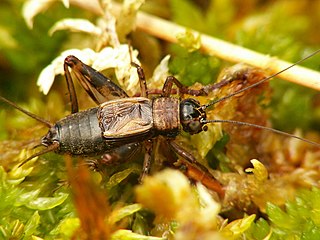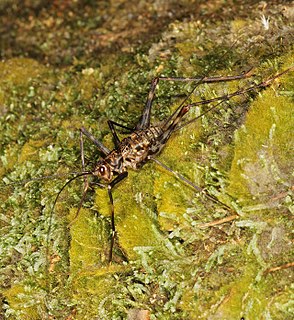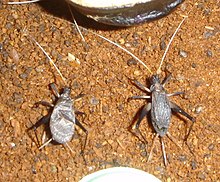
The family Gryllidae contains the subfamilies and genera which entomologists now term true crickets. They belong to the Orthopteran subfamily Ensifera, having long, whip-like antennae and has been reduced in terms of the older literature, with taxa such as the spider-crickets and allies, sword-tail crickets, wood or ground crickets and scaly crickets elevated to family level. The type genus is Gryllus and the first use of the family name "Gryllidae" was by Walker.

Eremiaphilidae is a small Old World family of praying mantids, based on the type genus Eremiaphila. As part of a major revision of mantid taxonomy, this family now contains the subfamily Tarachodinae, which includes tribes and genera previously placed in the now obsolete Tarachodidae.

The Myrmecophilidae or ant-loving crickets are rarely encountered relatives of mole crickets, and are obligate inquilines within ant nests. They are very small, wingless, and flattened, so resemble small cockroach nymphs. The few genera contain fewer than 100 species. Ant crickets are yellow, brown, or nearly black in color. They do not produce sound, and lack both wings and tympanal organs ("ears") on the front tibia.

Trigonidiinae is a subfamily of insects in the order Orthoptera, suborder Ensifera, based on the type genus Trigonidium. They are often referred to as sword-tail crickets, winged bush crickets or trigs.

The Eneopterinae are a subfamily of crickets, in the family Gryllidae, based on the type genus Eneoptera. It is one of several groups widely described as "true crickets". Of the more than 500 species that make up this subfamily, most occur in moist, tropical habitats. These insects are medium to large and brown or gray in color. They eat plant leaves, flowers, and fruits and can occasionally cause economic damage. Their eggs are deposited in pith, bark, or wood. Eneopterinae show a great diversity in stridulatory apparatus, signals emitted, and associated behaviour.

Grylloidea is the superfamily of insects, in the order Orthoptera, known as crickets. It includes the "true crickets", scaly crickets, wood crickets and other families, some only known from fossils.

Nemobiinae is a subfamily of the newly constituted Trigonidiidae, one of the cricket families. The type genus is Nemobius, which includes the wood cricket, but members of this subfamily may also be known as ground crickets or "pygmy field crickets".

Homoeogryllus is a genus of cricket in the subfamily Cachoplistinae and tribe Homoeogryllini. The recorded distribution is: Africa and Peninsular Malaysia.

The Trigonidiidae are a family of crickets: Grylloidea consisting of two subfamilies:

Paranemobius is a genus of cricket in the subfamily Nemobiinae; species can be found on the Indian subcontinent including Sri Lanka.

The Phalangopsidae are a recently reconstituted family of crickets, based on the type genus PhalangopsisServille, 1831 from South America. Priority for family-group names based on this genus dates from Blanchard's "Phalangopsites".
The Phaloriinae is a subfamily of crickets of the family Phalangopsidae. Species are terrestrial and are distributed in: Africa, tropical Asia, Korea, Australia and the Pacific Islands.

Meloimorpha is a genus of cricket in the subfamily Cachoplistinae and tribe Homoeogryllini. The recorded distribution is: India, China, Korea, Japan and Vietnam.
Cacoplistes is the type genus of cricket in the subfamily Cachoplistinae; it has been placed in its own tribe, the Cachoplistini. Its recorded distribution is: India, southern China and Indo-China.
The Landrevinae are a subfamily of crickets, in the family Gryllidae, based on the type genus Landreva. They are terrestrial, omnivorous and may be known as "bark crickets"; genera are distributed in: Central and South America, Africa, tropical Asia, Korea, Japan, Australia and the Pacific Islands.

Gryllini is a tribe of crickets and typical of the family Gryllidae. Species are terrestrial, carnivorous or omnivorous and can be found in all continenents except Antarctica.

Gryllodes is a genus of crickets in the family Gryllidae and tribe Gryllini. Species have been recorded in Australia, Asia, Africa (Ethiopia), central Europe, subtropical and tropical Americas.
Plebeiogryllus is a genus of crickets in the family Gryllidae and tribe Gryllini. Species have been found in the Indian subcontinent, southern China, Indo-China and the Philippines.

The Gonypetidae are a new (2019) family of praying mantids, based on the type genus Gonypeta. The first use of "Gonypetidae" was by Westwood and it has been revived as part of a major revision of mantid taxonomy; the subfamily Iridopteryginae having been moved here from the obsolete family Iridopterygidae. The Gonypetinae include Asian genera transferred from the obsolete taxa Amelinae and Liturgusidae.
Asarcogryllacris is an Asian genus of Orthopterans, sometimes known as 'leaf-folding crickets': in the subfamily Gryllacridinae and tribe Asarcogryllacridini. Species have been recorded from Indochina and west Malesia.














